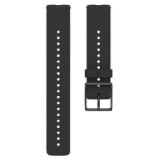What are heart rate zones?

Heart rate zones
Just like your resting heart rate and maximum heart rate, your heart rate zone limits are individual, and this is why they’re generally defined as percentages of your maximum heart rate.
Heart rate zone 1 1�7 Very light: 50-60% of HR max
Training in zone 1 improves your overall health and helps you recover from more demanding training.
How does it feel?
It feels very easy. You could go on for hours.
Heart rate zone 2 1�7 Light: 60-70% of HR max
Training in zone 2 develops your general endurance: it improves your body’s ability to utilize fat as an energy source, or in other words to burn fat.
How does it feel?
It still feels comfortable and easy. You could go on for hours.
Heart rate zone 3 1�7 Moderate: 70-80% of HR max
Training on zone 3 improves your aerobic fitness. On zone 3 lactate starts to build up in your bloodstream, but your body can reuse it as energy, and it won’t yet affect your performance.
How does it feel?
You’ll start breathing deeper and feel a moderate effort.
Heart rate zone 4 1�7 Hard: 80-90% of HR max
Training on zone 4 improves your speed endurance, and your body gets better at using carbohydrates for energy. It also improves your body’s ability to withstand higher levels of lactate in your blood.
How does it feel?
You’ll feel fatigue in your muscles and breathe heavily.
Heart rate zone 5 1�7 Very hard: 90-100% of HR max
Training on zone 5 improves your maximum performance. A lot of lactate is building up and you won't be able to continue for long.
How does it feel?
It’ll feel exhausting for breathing and muscles.
Heart rate zones in different sports
There is some fluctuation in heart rate zones depending on the sport. For example, take cycling and running on the same level of intensity: the cyclist’s heart rate is 5-10 beats slower than the runner’s. This is because cyclists don’t need to support their own bodyweight and their muscles can use most of the available oxygen for moving forward. Also, the number of working muscle groups is smaller in cycling. In swimming heart rate is even lower, usually about 5 beats below cycling.
Further reading
- How to use ZoneLock (Grit X/Pacer/Vantage)
- The what and how of speed and pace zones
- https://www.polar.com/blog/running-heart-rate-zones-basics/
- https://www.polar.com/blog/basic-endurance-training/
- https://www.polar.com/blog/tempo-training/
- https://support.polar.com/e_manuals/M460/Polar_M460_user_manual_English/Content/Speed_and_Power_Zones.htm


































